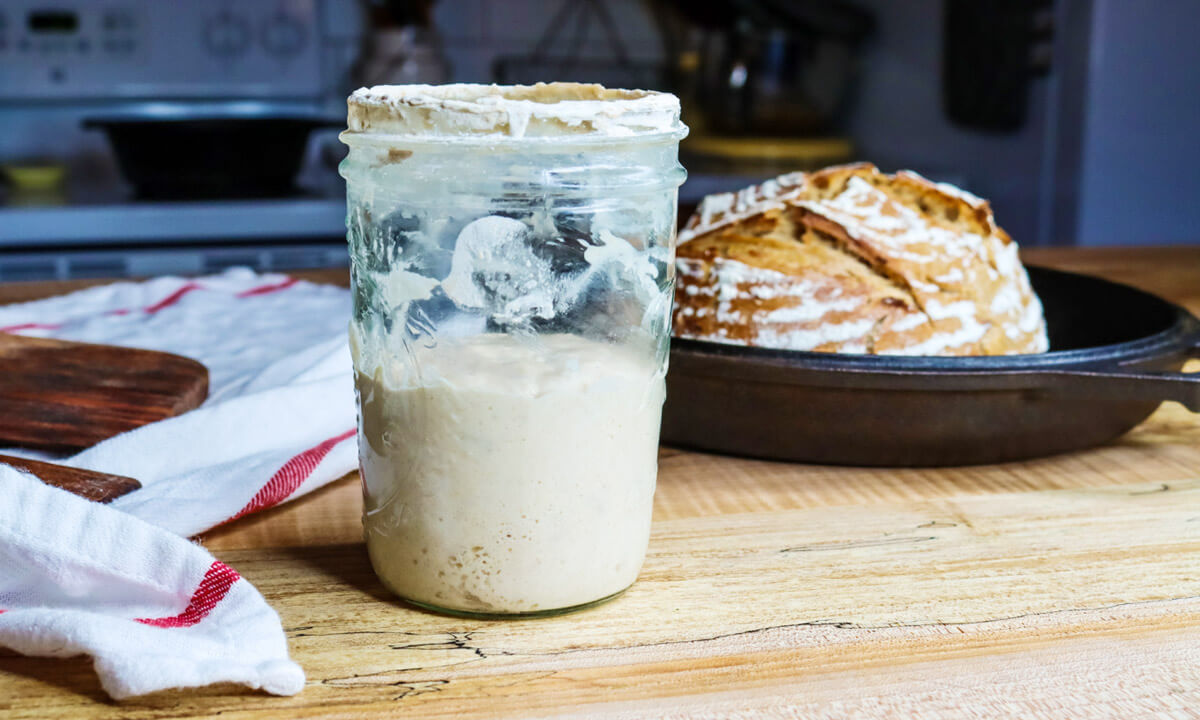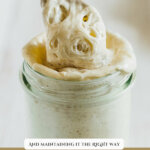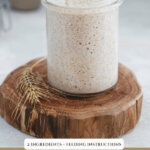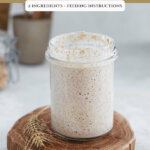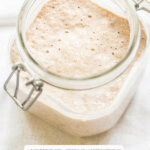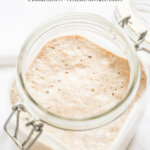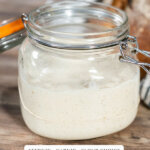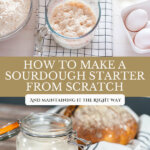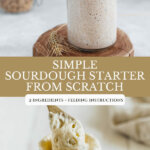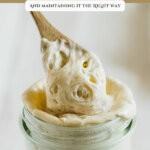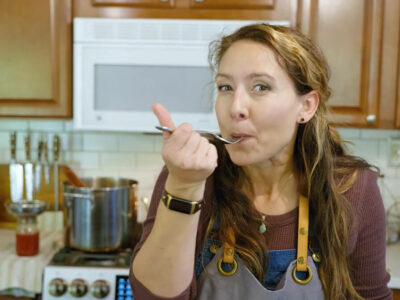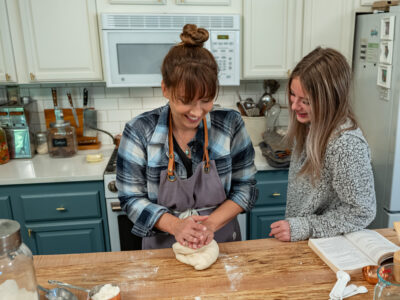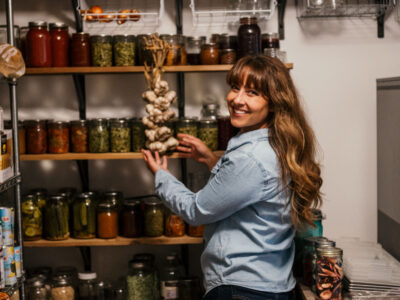Learn how to easily make a sourdough starter from scratch with just two simple ingredients: flour and water. Catching the wild yeast in the air sounds strange, but it's so simple! Once your starter is bubbly and happy, you'll be able to make all kinds of sourdough recipes. I'm talking sourdough bread, pizza crust, cakes, cookies and so much more!
Let's make a sourdough starter that actually WORKS! Most of us have eaten sourdough at one time or another in our lives, whether cookies or cakes, pizza crust or sourdough tortillas.
Some of us love that tangy sourdough flavor, while others of us don't really like the sourness of it (there are tips for less sour sourdough!). Wherever you stand, you're gonna wanna stick around and learn more about all of the amazing benefits of sourdough and about why you should consider making your own sourdough starter completely from scratch.
Why You'll Love My Sourdough Method
If you've tried making a sourdough starter before, you may have had some failures in the past. Maybe the sourdough starter didn’t grow as it was supposed to or you were successful with getting your starter off the ground and going, but when baking your bread, you had loaves that were dense as a rock.
My hand is raised, y’all. Even though my husband and I enjoy the sour flavor of sourdough, our bread was so sour that we didn't even like it.
My kids don't like even a hint of sour flavor, so we generally err on the side of less sour and everyone is happy.
For the best success, I highly recommend listening to Episode #288, How to Start a Sourdough Starter, of the Pioneering Today Podcast as well as watching both the video above and below in this blog post. You'll soon be armed with all the information you need to make a successful sourdough starter.
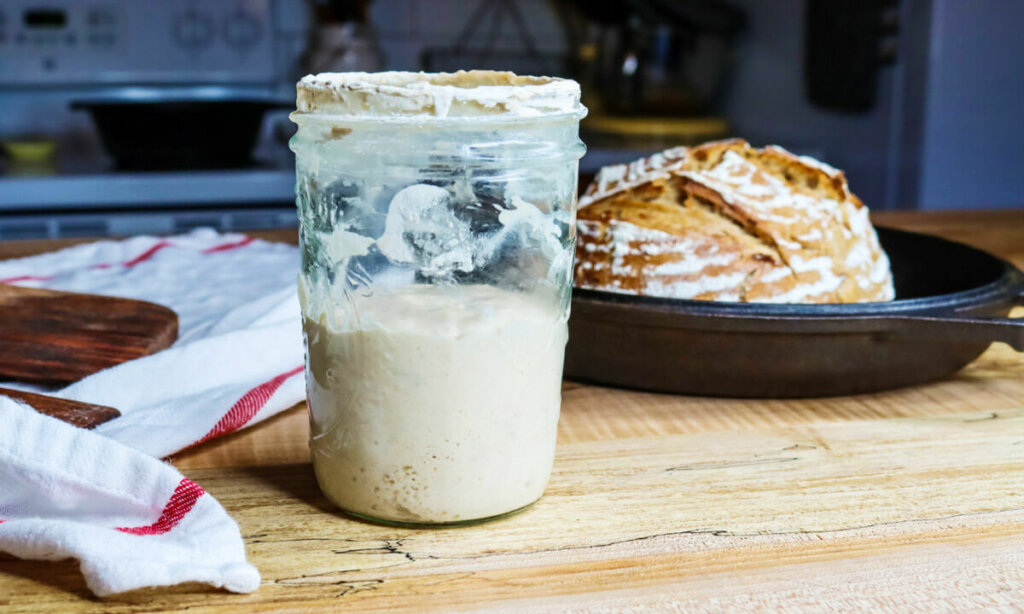
Tips for Sourdough Starter Success
I've definitely had a love/hate relationship with making sourdough. Not to mention, there have been a few times I've had a successful sourdough starter going, only to leave it in the oven while it's preheating accidentally! So frustrating!
If you’ve found yourself in any of the previous scenarios and you're nodding your head, then this post is for you. Here are a few tips to know about when getting started:
- Safe Storage – I'll recommend storing your sourdough starter in a warm location. For some, this may mean a cold oven with the light turned on. I've hit preheat on my oven a time too many to know this option isn't safe for my sourdough starter. I now store it in the refrigerator and feed it once a week (or the day before I need to bake with it). This eliminates the possibility of killing my starter in the oven! Sourdough starter likes to be warm, like a warm room temperature. The top of the refrigerator is also a great spot.
- Ingredients – Sourdough starter only needs flour and water to get started. If you find a recipe that recommends adding ingredients such as sugar or yeast, toss that recipe out! You'll end up with a moldy, stinky mess.
- Flour – Flour choice is important (more on that below). Don't limit yourself to only one flour choice! Mix it up until you find your favorite.
- Feeding Schedule – You'll see an example feeding schedule below. Once your starter is established, don't feel like you need daily feedings anymore. You can store your sourdough starter in the refrigerator where it will “hibernate,” meaning you only need to pull it out once a week for feedings.
- Have Fun – There is a lot of information out there about sourdough baking. It can get extremely technical with hydration percentages, weights and measurements, feeding timings, etc. In my experience, you can get very fussy about it or just have fun and experiment. I think you'll soon find that specific measurements and timed feedings aren't only unnecessary but also take too much bandwidth. A sourdough starter is extremely flexible. Find a routine that works best for you.
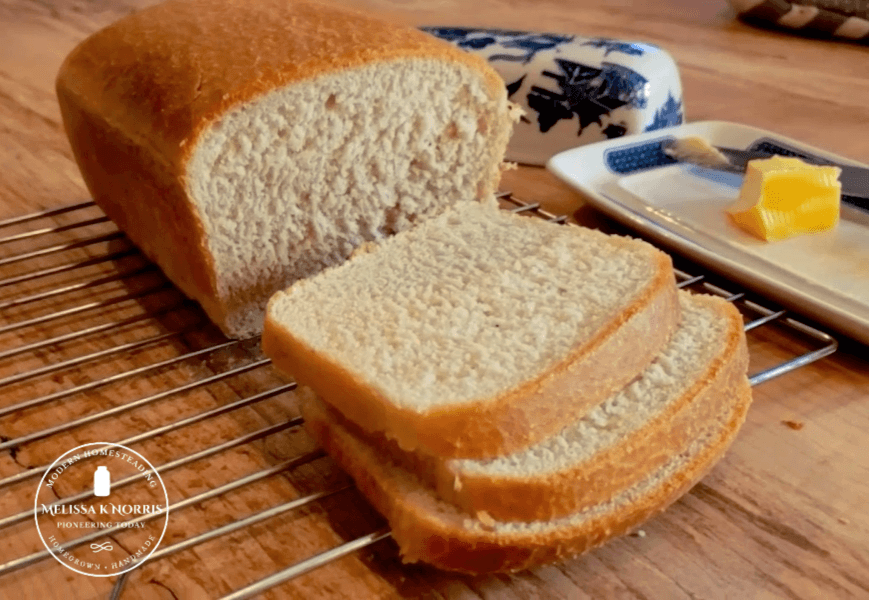
Health Benefits of Sourdough
The beauty of sourdough is that it contains bacteria and yeast. Though that doesn't necessarily sound like something we want to eat, if you've heard about the benefits of fermented foods, then you'll know it is.
This yeast and bacteria are essentially consuming the mixture of flour and water, meaning they are pre-digesting the flour for us. This is really good for our gut health, which is why live cultured and fermented foods of all kinds are so good for our digestive system and overall health.
When it comes to sourdough though, the bacteria isn't alive when we eat it because we're not eating our sourdough starter raw. We’re using it to bake with. However, when we add our flour, or whatever grain medium we're using (ie. brown rice, quinoa, buckwheat, gluten-free flour, etc.), it's being pre-digested during the soaking or rising phase.
This means our bodies can get the nutrients out of it much easier, even though we’re baking it.
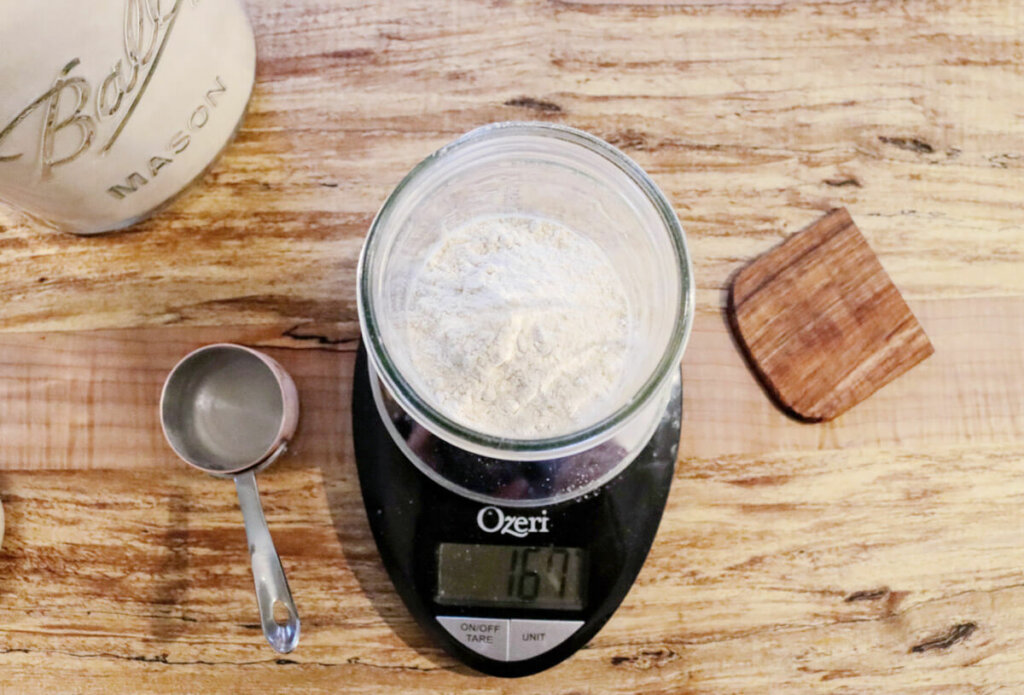
Best Flour to Use for Sourdough Starter
You can use any grain or flour that you want to start your starter! In my sourdough class, I teach you how to make a sourdough starter from 4 different types of grains: all-purpose, ancient grain einkorn, fresh-ground hard white wheat and gluten-free brown rice flour.
- Hard White Wheat – This is my go-to for feeding my sourdough starter because, most of the time, I'm baking bread that I want to have a higher gluten and protein content (so I get a nice tall rise). Looking for a soft and sliceable sourdough sandwich bread recipe? Give my best beginner sourdough sandwich bread recipe a try!
- Spelt – This flour is great for making pancakes, waffles, cakes and other pastries. It has a lower gluten and protein content, which creates soft and fluffy baked goods.
- Soft White Wheat – This is another option for light and fluffy baked goods such as pancakes, waffles and cakes.
- Pastry Whole Wheat – This also makes delicious baked goods and pastries due to the low protein content. All-purpose flour generally contains about 10-12% protein, whereas pastry flour contains about 8-9%.
- Ancient Grain Einkorn – A great option if you're looking for flours that are easier to digest. I generally save my einkorn flour for baked goods that aren't sourdough, but it also works wonderfully for sourdough. If you're not used to baking with ancient grains, I recommend checking out this post health and baking tips for Einkorn flour.
- Gluten-Free Brown Rice – This is a great gluten-free option. Many people like to create gluten-free blends, but I find having a single flour sourdough starter is easiest and works just as well for gluten-free baking. You can make your recipe with additional gf flour added for better consistency, but the starter itself can just be a single flour. You may enjoy this post on successful gluten-free baking that actually tastes good.
For my recommendations on where to find hard white wheat and other grains, check out this post on where to buy grains in bulk.
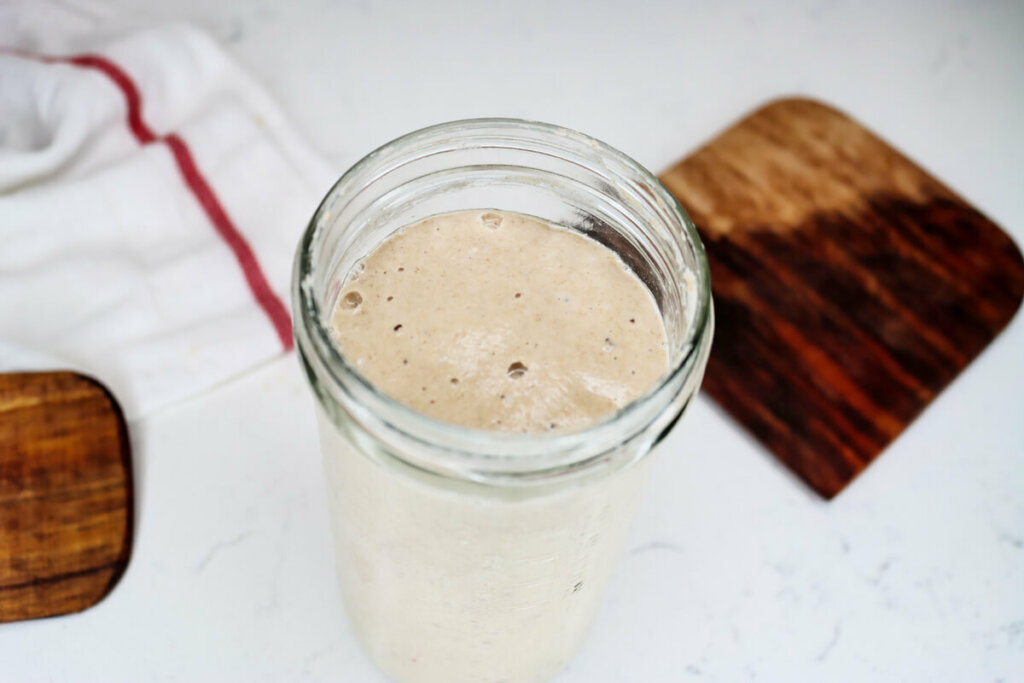
What is Sourdough Discard?
This is where sourdough can become confusing. Sometimes, it can feel like people are speaking another language… starter, discard, hydration, feedings, autolyze… the list of terms goes on and on.
Sourdough “discard” does not mean we're throwing or discarding the sourdough starter. It simply means we're removing some of the previously fed sourdough starter from the container and adding it to a new “discard” container to be used in recipes (see the list of sourdough discard recipes below).
Discarding your starter is very important at the beginning when you’re getting your starter established. It's also something that will come into play later on if you put your starter to sleep in the fridge and you need to bring it back to life!
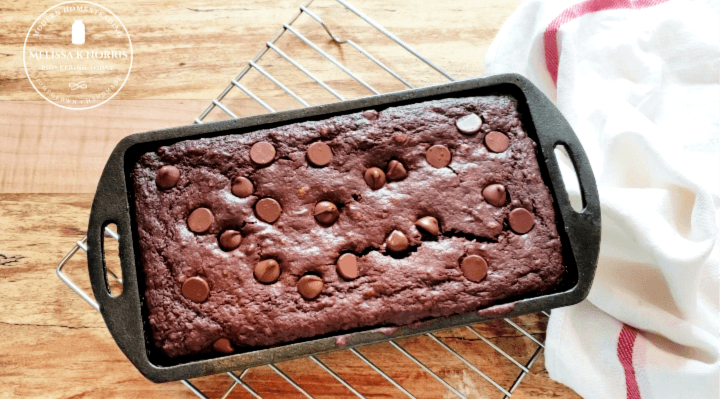
Sourdough Discard Recipes
Before your starter is mature, meaning it's not yet strong enough to raise a loaf of bread, you can use the starter and the discard to bake all kinds of sourdough goodies. This discard can continue to be used once your starter is strong!
You do NOT want to try and bake a loaf of bread when your sourdough starter is in its infancy. You'll just get discouraged when the loaf doesn't rise. Experiment with these sourdough discard recipes instead:
- Pancakes and Waffles – Get my sourdough pancake and waffle recipe in video three of my sourdough series.
- Cakes and Brownies – This sourdough chocolate cake tastes incredible and is so light and fluffy!
- Cookies – These sourdough chocolate chip cookies are a must-try!
- Muffins – Sourdough discard muffins are a win. This sourdough muffin recipe has so many variations and mix-ins to try!
- English Muffins – Looking for a friendlier breakfast sandwich option? Try making sourdough English muffins.
- Tortillas – Sourdough tortillas are so simple to make and are a great addition to any taco night.
- Pie crust – In need of a flaky sourdough pie crust? Look no further!
- Crackers – Sourdough crackers may just be the easiest thing ever… well, maybe second to my five-minute cracker recipe.
- Quick bread – My all-time favorite is this chocolate sourdough bread. You won't even have to feel guilty eating it for breakfast!
Now, if you have my book Handmade, you know we walked through making a sourdough starter and I've got quite a few recipes already in there for using your starter and your discard.
In my class, I walk you through making sourdough pancakes and waffles with your discard. These types of recipes are especially helpful when your starter is in its infancy because, as I mentioned, you can't use it to bake bread yet.
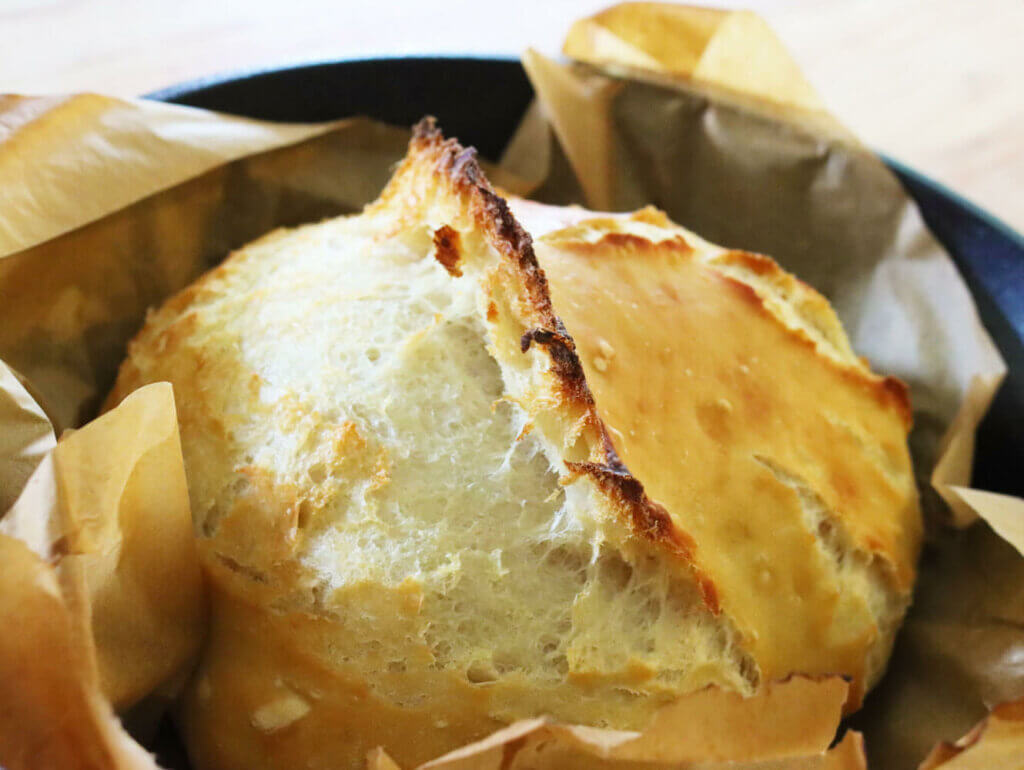
When is My Starter Strong Enough For Baking?
How do we know when our sourdough starter is strong enough to bake up amazing loaves of bread? You'll want to catch my free class to know just when your starter is ready. But the short answer is at least 4 weeks of age and consistently doubling in size a few hours after being fed.
In my class, we even dive into how to make sourdough bread, which is really interesting because it’s a different technique than using active dry yeast for homemade bread.
Since a sourdough starter is a living thing and it reacts differently to different temperatures, humidity levels, etc., you have to learn how to nurture your starter until it’s ready to bake bread with. Once you know what it's supposed to look like and how to manipulate it, it really is easy to make amazing bread!
I make sandwich bread with 100% sourdough starter (no active dry yeast in these loaves!). Lovely sliceable, barely-any-crumb sandwich bread that's not full of holes (because for sandwich bread, we don't want to have those huge holes because then all your stuff comes smushing out everywhere!).
You can also take that same sourdough starter and turn it into more artisan-style loaves, such as big round loaves, French bread rolls, jalapeno cheddar boules… the list goes on and on.
When you're ready to bake, here are my Sourdough Baking Tips & Tricks for Success.
How to Revive a Sourdough Starter
YIKES! Have you ever completely forgotten about your sourdough starter after tucking it in the back of the refrigerator? You're not alone!
I revived a sourdough starter that was tucked in the back of the refrigerator for SIX months! After a little TLC, it came back to life and was stronger than ever.
Check out this post to learn how to revive a sourdough starter. This is great to know in case you want to take a break from sourdough baking, but don't want to have to start from scratch with a brand new sourdough starter.

>> Sign up to join my sourdough class for free! <<
How to Make a Sourdough Starter
If you've heard the terms “wild yeast” or “wild fermentation,” that’s exactly what we're doing when we make a sourdough starter. We’re capturing that wild yeast and growing our starter with naturally occurring yeast and bacteria.
Once we understand our sourdough starter is a living thing, it’s easy to see why it doesn’t just taste good, but, like all fermented foods, it’s beneficial to our health too. Plus, the fact that it’s fermented means that it’s got natural preservatives because fermentation is basically nature's way of preserving food.
Now that I've filled you in on all the basics, here's how to start your very own sourdough starter…
Ingredients
- ¼ cup flour (30 grams)
- 2 Tablespoons warm water (30 grams)
Directions
- Mix together ¼ cup flour and 2 Tablespoons water (or 30 grams of each for 100% hydration sourdough starter).
- It's ideal to use warm water, around 65 to 70°F. If your house is on the cool side, you can increase the water temperature to 80 to 85°F.
- Every 12 hours (or so), discard half your starter and feed it with the amounts listed again. You can see my example sourdough starter feeding schedule below.
Feeding Your Sourdough Starter
At each feeding, you’ll use ¼ cup (30 grams) of flour and 2 Tablespoons (30 grams) of water. Your goal is a thick, pancake-like batter consistency. If your starter looks a little thin, add a bit more flour. If it looks too thick, add a bit more water (remember, we don't have to be fussy about this!).
Try to keep your feedings 12 hours apart, but don’t stress or set a timer. Twice a day is ideal to keep your new lactobacilli bacteria fed, where they can multiply to establish your colony. I like to feed my starter once in the morning and once before I go to bed.

Example Sourdough Starter Feeding Schedule
Day 1
AM feeding = Add equal parts flour and water (by weight), or about 1/4 cup flour and 2 tablespoons warm water, and stir until well combined. Scrape down the sides and bottom of the jar to make sure everything is incorporated.
PM feeding = Add equal parts flour and water (by weight), or about 1/4 cup flour and 2 tablespoons warm water, and stir until well combined. Scrape down the sides and bottom of the jar to make sure everything is incorporated.
Day 2
AM feeding = Discard ½ the amount of your starter (this is very important to establish your starter with a healthy colony). Add equal parts flour and water (by weight), or about 1/4 cup flour and 2 tablespoons warm water, and stir until well combined. Scrape down the sides and bottom of the jar to make sure everything is incorporated.
PM feeding = Add equal parts flour and water (by weight), or about 1/4 cup flour and 2 tablespoons warm water, and stir until well combined. Scrape down the sides and bottom of the jar to make sure everything is incorporated.
What you might see: You may start to see a bubble or two!
Day 3
AM feeding = Discard ½ the amount of your starter (this is very important to establish your starter with a healthy colony). Add equal parts flour and water (by weight), or about 1/4 cup flour and 2 tablespoons warm water, and stir until well combined. Scrape down the sides and bottom of the jar to make sure everything is incorporated.
PM feeding = Add equal parts flour and water (by weight), or about 1/4 cup flour and 2 tablespoons warm water, and stir until well combined. Scrape down the sides and bottom of the jar to make sure everything is incorporated.
What you might see: You should be seeing quite a bit of bubble action now! Some starter will even double at this point BUT it’s not ready for bread. If your starter is extremely bubbly right now, don’t be alarmed if at day 5 or beyond it suddenly stops being so bubbly, this is normal for a young starter.
Day 4
AM feeding = Discard ½ the amount of your starter (this is very important to establish your starter with a healthy colony). Add equal parts flour and water (by weight), or about 1/4 cup flour and 2 tablespoons warm water, and stir until well combined. Scrape down the sides and bottom of the jar to make sure everything is incorporated.
PM feeding = Add equal parts flour and water (by weight), or about 1/4 cup flour and 2 tablespoons warm water, and stir until well combined. Scrape down the sides and bottom of the jar to make sure everything is incorporated.
Day 5
AM feeding = Discard ½ the amount of your starter (this is very important to establish your starter with a healthy colony). Add equal parts flour and water (by weight), or about 1/4 cup flour and 2 tablespoons warm water, and stir until well combined. Scrape down the sides and bottom of the jar to make sure everything is incorporated.
PM feeding = Add equal parts flour and water (by weight), or about 1/4 cup flour and 2 tablespoons warm water, and stir until well combined. Scrape down the sides and bottom of the jar to make sure everything is incorporated.
What you might see: Even if you don’t see signs on days one or two, continue with the feeding routine and have patience. Your starter will likely smell yeasty, sour, tangy and or even like alcohol in the beginning stages.
You now have an active but young sourdough starter and can begin using it in non-rising sourdough recipes (discard recipes) like pancakes, waffles, muffins, quick breads, crackers, and cakes.
Day 6 through 28
At this point, you can continue with the twice-daily feeding amounts OR use the alternate once-a-day feeding.
Alternate once-a-day feeding is to add ½ cup flour (60 grams) and ¼ cup water (60 grams). This can be used once your starter is bubbly and active. If you feel it's sluggish, stay at the twice-a-day feedings and amounts.
Once your starter is 4 weeks old, it will likely show consistent signs of doubling a few hours after feeding and be ready to try in bread recipes.
Why You MUST Discard Half Your Starter
Don’t skip the discard. As mentioned above, this is important during the beginning stages of a new sourdough starter and means you’ll use less flour throughout the first week. The lactobacilli aren’t established and can’t sustain the full amount of flour and water if you don’t discard them.
If you'd like, you can use the discard in regular recipes that call for flour and water, but it's not truly a sourdough discard yet (not to mention it's only a small amount).
Other options are to add it to your compost pile, feed it to your livestock, or throw it in the trash. DON’T put it down your sink unless you want to call a plumber.
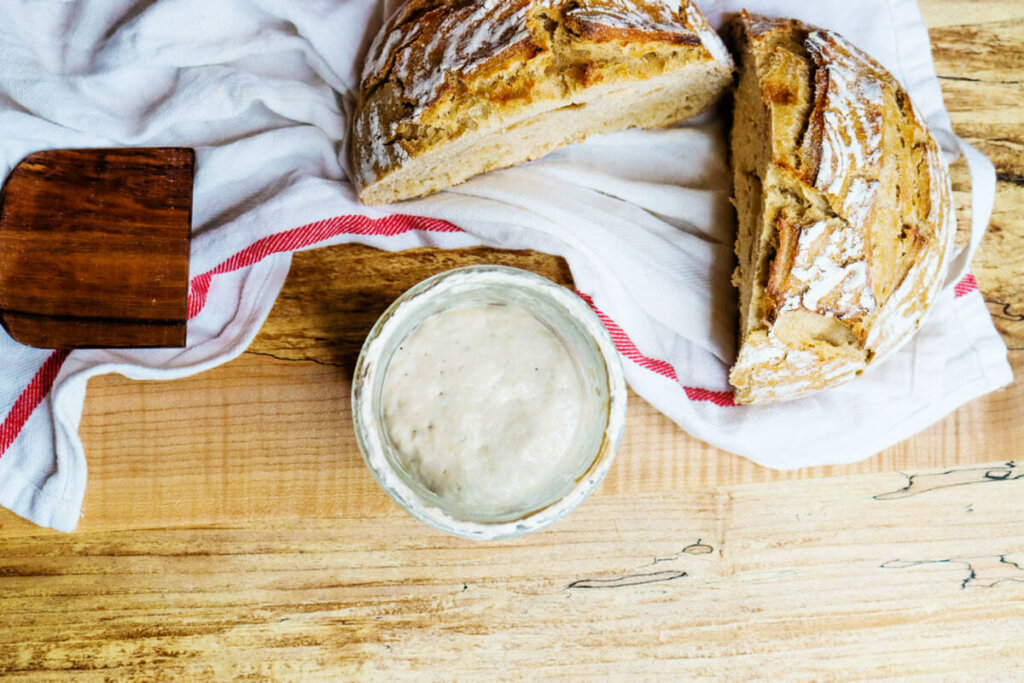
Where to Store Sourdough Starter
The best temperature for your starter is between 70-85° Fahrenheit. Our house cools down between 60-65°F overnight as the woodstove cools and then is back in the low to mid 70s during the day and evening, and my starter does just fine.
You don't have to be too fussy with your starter. If you’re seeing good bubble action, don’t worry if your temperatures dip.
If your house is consistently colder, you can place your starter near a heat source (not on it; we don’t want to cook it), on top of the refrigerator or in the oven with the light on (just don't forget it's in there when you need to preheat your oven!).
Signs Your Starter Is Active
A healthy and mature sourdough starter will show lots of signs of activity:
- Bubbles on the sides of the jar
- Bubbles on the top of the jar
- Domed on top a few hours after feeding
- Starter doubling in size a few hours after feeding
- Liquid on the top as you come due for the next feeding
Signs Your Starter Has Gone Bad
There's really no mystery here. Honestly, you'll know! There's a difference between a strong fermented smell and a putrid, rotten, or rancid smell. Sourdough starter can smell like vinegar or a strong alcoholic smell, but that doesn't mean it's bad.
It can also build up a dark liquid layer, called “hooch,” and that's also harmless. Sometimes the top of the starter will even turn gray and get firm. All you need to do is pour off the liquid and/or scrape off the thick gray layer, feed it, and continue with daily feedings until it's bubbly and active again.
What you don't want to see is pink, gray, green, or black fuzzy mold. Also, if it smells putrid, like you may get sick after smelling it, those are signs that your starter has gone bad.
Trust me when I say, sourdough starters are extremely resilient and I've neglected mine for an extremely long time without them going bad (like, forgetting them in the back of the refrigerator for months on end!).

Sourdough Starter
Ingredients
- 1/4 cup flour all-purpose, whole wheat, fresh ground, etc.
- 2 tbsp water warm
Instructions
- Mix together flour and water in a pint mason jar, cover jar with cheese cloth or coffee filter and set in a warm area of your house for 12 hours.
- After 12 hours, feed your starter the same amounts again, cover and let sit 12 hours.
- On the second day, discard half the starter, then feed with 1/4 cup flour and 2 tbsp warm water. Cover jar and let sit another 12 hours.
- After 12 hours, feed your starter the same amounts again, cover and let sit 12 hours.
- Repeat these steps for 5 days, discarding half the starter once daily, but continuing with the twice daily feedings.
- By about the 6th day you should have pretty bubbly starter that is great for baking pancakes, waffles and other pastries, but might not be ready to bake a loaf of bread.
- On day 6 you can switch to feeding once per day (see instructions in the post), and keep using your starter in the sourdough starter recipes listed above.
- By week 4 your starter should be ready to bake bread (see notes in the post on how to know if your starter is ready to bake a loaf of bread).
Notes
- Be sure to feed with the same kind of flour (or the same combination of flours) throughout the whole first month.
- On days 1-4 of your new starter, your discard won't be ready to use in sourdough recipes like pancakes, waffles, muffins, etc., but you can use it in the place of flour and water in recipes that call for it.
- By day 5, you will finally have a sourdough starter, although it won't be strong enough for bread baking, you can use it in recipes like waffles, pancakes, muffins, and chocolate sourdough bread.
- On day 6, you can switch to once a day feedings, or continue feeding twice daily.
Nutrition
Melissa K Norris: Hey pioneers. Welcome to episode number 288. Today's episode, we are going to be talking all things sourdough, specifically sourdough starter. Because most of the time when people have failures or issues or you're not quite happy with your sourdough bread, it all comes back to that sourdough starter and your starter isn't as robust as it should be. So this is the episode for you if you don't have a sourdough starter and you're wanting to start one, so that you can get one going the correct way from the very beginning. And if you have a sourdough starter but like I said, maybe it's not performing as well as you would like, or what you think it should be doing, then you are going to glean a ton from this episode. So in this episode, I'm going to be sharing with you the basics on how to create a sourdough starter.
Melissa K Norris: And like I said, even if you have a sourdough starter, you can still use these tips to get it into tip top shape. But I also am doing a very special, live class that you have time to sign up for. So you go to melissaknorris.com/starter for my nine tips for a better sourdough starter that you probably aren't doing, and that will pick up where this episode will leave off. Because I can only do so much in one episode. So I highly encourage you to go and get signed up for that class. I will be doing live Q and A at the end, we're going to have some fun giveaways, some a great downloads with recipes and schedules that you're going to want to get your hands on, and all of it's for free, by the way. I don't know if I mentioned that. So I want to make sure that you know about it and that you go and get your seat. So melissaknorris.com/starter to go and get your seat reserved for that very special class. Let me officially welcome you to the podcast though.
Melissa K Norris: Sourdough is something that I find a lot of people get intimidated by, or they're not really sure that they want to jump into it. So I'm going to share with you ... Excuse me, a little bit of a frog in my throat there. Sorry about that. So I'm going to share with you my sourdough starter story, and that is how I came up with the tips and the way that I do sourdough now, that I'm going to share with you. So I have always loved the flavor of sourdough. I have always liked whole wheat, and I've always liked that tangy flavor of sourdough. So more of those hardy types of breads. But growing up, my mom actually does not like sourdough and she does not like whole wheat. So all we ever had was white bread. After I got married, my husband also always has liked sourdough.
Melissa K Norris: And so I decided I was going to start baking our bread and I wanted to do a sourdough starter. So, and this is where many of you are probably going to relate, so I started my sourdough starter based on advice that said to use a packet of regular store-bought yeast, flour, and water, which is a very bad way to start a starter, and mine completely failed. It developed all kinds of mold, black and pink mold. Did not work at all. Now, the reason that I start from that point is because a sourdough starter should only have two ingredients for a real true sourdough starter, and that is flour and water. So a sourdough starter recipe, two ingredients, flour and water. Now, when it comes to the types of flour that you can use, you can use pretty much any type of flour that you want.
Melissa K Norris: I have done sourdough starters with all purpose flour. I've done it with bread flour. I have done them with fresh ground hard white wheat. I have done them with iron corn, ancient grain, and I've also done gluten-free sourdough starters as well. Because I have been teaching people online, how to make sourdough starter now for a number of years, in my book Hand Made, I have had to do a sourdough starter and I had a lot of people asking how to do starters with lots of different types of flours. So I started all of these different starters, kept them going as I was filming my full sourdough bread baking course, and developed recipes using each of those different types of starters. So when I say you can use almost any type of flour to make a starter, you absolutely can, but there are some best practices for picking your flour to make your sourdough starter.
Melissa K Norris: And I like to use organic, unbleached, all purpose flour if I am using store-bought flour. So you can use store-bought whole wheat flour. You can do any of those types of flours that you want, but ideally organic and unbleached is going to give you the best bang for your buck. Now, when it comes to gluten free flours, in my experience, the ones that work the best has been a rice flour, buckwheat works great, and also quinoa works really well. What I would stay away from when making a gluten-free starter as far as flours go would be things like coconut and almond flour. One, because these are nut flowers. They're not grains that have a lot of starches and carbs in them. And one of the important things that you need to understand about your sourdough starter is it is a living organism. So it is a combination of yeast and lactobacillus bacteria, which is good bacteria.
Melissa K Norris: I know often times we think bacteria and we think, oh no. But there's a lot of good bacteria out there and those organisms need food to eat. And so they consume the starches. So I would not recommend doing your sourdough starter with something like those nut flours. Like I said, something that has a starches in them, with the rice, the buckwheat, and the quinoa have in there, and they have sustained gluten-free sourdough starters very well. Now, the other ingredient is our water. I get a lot of questions asked about that. Now, if you are on city water that has a lot of chlorine in it, or is treated with a lot of chemicals, then you either have the option of letting that water set out for about a day or overnight to let those chemicals off gas or evaporate out. Or you can bring that water to a boil and let it cool back down to room temperature and you can use that.
Melissa K Norris: We are on our own private well, and I have had no problem using our well water. There's no need to go and buy distilled water or some type of special water for your sourdough starter. Unless like I said, it is very heavily treated with chemicals or you don't have a really good filter system to filter out some of those chemicals if you're on a city type of water. So that being said, it is just your flour and your water. Now, where does the yeast come from? Because that is essentially what we're doing is we are creating an environment with the flour and the water that is very friendly to the yeast and the good bacteria so that they have a breeding ground and that they can breed and grow. Which sounds kind of weird. We're talking about food. But you have the yeast and the lactobacillus bacteria. It's already on the surface of most grains.
Melissa K Norris: It can be in the surfaces of your home, your skin, et cetera. And so what we're doing is, like I said, we're actually creating an environment that it's going to be very happy in and it's going to proliferate and it's going to grow. We're not actually making yeast per se. It's already on the grains. Now, a lot of people prefer to do, like I said, the unbleached and organic and/or the whole wheat. You'll oftentimes hear people say they will start with rye flour for their sourdough starters because those tend to be grains, but the whole wheat flour, as well as rye, that there seems to be a lot of natural yeast on there, in a higher content than say, just regular all-purpose flour from the store. And so a lot of people feel that they get started easier by using those flours. However, like I said, I have made numerous starters and walked over a thousand people in my bread course, thousands of people that went through my sourdough starter series videos, and have been able to create their starters without purchasing any type of special flour.
Melissa K Norris: But just so you know why you will see that and why some people choose to use those flours more so than other ones. That's kind of the reasoning and the thought process behind there. But you can be very successful with any of those flowers that I've already outlined for you. Now, when you're first getting ready to start your starter on day one, I like to use a Mason jar or a glass bowl. I just find that a ... I like to use a wide mouth pint size Mason jar. It's works really well, and I just use the same Mason jar all the time. I very rarely ever clean out my Mason jar, sourdough starter vessel.
Melissa K Norris: Now, the amount of flour and water that you're going to use to start your starter, you will see, again, varying amounts all over. And if you have my book Hand Made, then you'll see that in that one, I started out saying that I use six tablespoons of flour with four tablespoons of water. I've done sourdough starter videos, if you went through any of my sourdough starter videos online, and you'll see that I used four tablespoons of flour. There is a difference in the amount of flour and my friends, that's because you can use as much or as little flour, really, as you want. Now, I would not go beneath the four tablespoons of flour, but really, you just need to have enough flour and water to be able to feed the yeast and the bacteria and to keep it going and happy and healthy. And I prefer to use less flour because I don't want to just be feeding it a whole bunch of flour. I don't keep a large amount of sourdough starter on hand at any given time because there's really no need to do so.
Melissa K Norris: So I have seen where people have huge crocks of sourdough starter. And I got to tell you, I am just too frugal. I am not going to invest that much flour feeding just a sourdough starter. And you can quickly get as much amount of starter as you need, if you need a large amount of starter for a recipe, very easily without maintaining this huge amount of sourdough starter. So if you were doing a sourdough starter in the past, you've seen it and it's like, man, it's using a ton of flour, then I think you're really going to like the method that I use. So day one, you're going to have a glass vessel and your flour and your water.
Melissa K Norris: So I use a quarter cup, which is four tablespoons of flour, to two tablespoons of water. Now, if you have a scale ... Now, I know in days gone by when they were making sourdough starter out on the prairie and all the different ... You know, sourdough starter has been around for a very, very long time as a way of leavening our bread before we had commercial yeast, which wasn't the active, dry yeast that we have in packets that you and I are used to seeing now on the store shelves, or on the store shelves prior to the pandemic. There's been times where it's been out and unable to get, but that yeast was really, became big during the 1940s when they needed yeast to be able to bake bread and to do things like that. Prior to that, you had yeast cakes, which I have never used, but I've seen in older cookbooks. And then before that we had sourdough.
Melissa K Norris: So you're going to just take your quarter cup of flour, and you're going to take your two tablespoons of water. Now, like I said, that is considered 100% hydration, which means if you have a scale, which a lot of people will use scales now to do sourdough because it makes it really easy to get the exact amount that you need if you're doing 100% hydration. 100% hydration simply means that it's 50% water and 50% flour by weight, not volume. And that 50% plus 50% equals 100% hydration. So that's all that means if you've heard that terminology before.
Melissa K Norris: Now, I've been doing sourdough so long now that I can tell. I don't even measure. I just take the flour out, put it in, add the water, and I can tell by the thickness if it's at 100% hydration, because I've been doing it for over a decade. But when you're first starting out, you don't have that experience. So if you have a scale, it's 30 grams of flour and 30 grams of water. If you don't have a food scale, quarter cup flour, two tablespoons water. So put that in your jar, and you're going to stir that and combine it until the flour is incorporated with all the water so we don't have any little dry bits of flour. Then I use just the white plastic screw down lids, and I just screw it a couple of threads because I don't want to get any ... You don't want it to be airtight so don't use a regular canning lid.
Melissa K Norris: You don't want it to be airtight and I'm fine using the plastic, reusable lids, but I don't really want to use plastic wrap. And so I just love those white, screw down lids. You can't can with them, but they're for the fridge or the freezer. And I just keep a whole bunch of those because I use my Mason jars for pretty much everything, leftovers and including my sourdough starter. Now, if you have though, glass jars are called like a Fido jar, and those are the glass jars that have like the wire and it's a glass lid and they have the rubber gasket and they're like the little wire Bell lid that you can then close them. I have used those for my sourdough starter in the past as well, and just tooken off the rubber gasket, but still closed it.
Melissa K Norris: And without the rubber gaskets, it is not airtight either, but you want to make sure, however you're closing up your vessel, that it's not airtight. It needs to be able to breathe. It needs the oxygen for the yeast and the culture. So it's an aerobic culture, not an anaerobic. So we want to make sure that there's oxygen present. Now, the warmer the room, the happier, or I should say the faster, a sourdough starter will consume its food and be more active. And this is true of really, any ferment. And that's why in the summertime, if you're used to doing ferments or even yeast with regular active dry yeast or instant dry yeast, whatever that yeast is, you know that the warmer the room, the faster the bread rises. Well, it's kind of the same thing with our ferments. And so ideally, between 70 and 78 degrees Fahrenheit is considered a really great temperature.
Melissa K Norris: But my home is usually pretty much even in the summer months. So we'll get a little bit hotter in the thing of summer, but I live in the North and the Pacific Northwest. Usually in the morning when I get up, my house is about 60 to 62 degrees Fahrenheit. And then we build a fire, and by the evening, afternoon, it's usually between 70 to 74 degrees Fahrenheit. So my home fluctuates between that temperature range and my sourdough starter does just fine. But in the beginning, when you're really trying to create that optimal environment for the yeast and the lactobacillus bacteria, then if you have a oven that you can turn just the light on in.
Melissa K Norris: Make sure you put a note so nobody preheats the oven with your starter in there. That can create a proofing box and it's in sort of really nice, warm environment. Or if you happen to have a microwave over top of your stove, which is how our house is, I can turn just the light on that lights ... It's the light over the stove. But because my microwave is in that same unit, it also makes the microwave really warm too. Obviously without turning it on. And so I can put my starter in there as well.
Melissa K Norris: So if you can find a warm spot like that, it's ideal, but if you don't have a warm spot, as long as your home is above 60 degrees Fahrenheit, you should be okay, but you can try and find a warm spot. Usually the fridge. Heat rises, right? So on top of the fridge, maybe next to a heat vent or a stove, whatever your heat source is. Obviously not on it, but next to it can also be some great spots. Now, with that sourdough starter, so we've mixed in that quarter cup of flour and the liquid.
Melissa K Norris: Then I like to start mine in the morning, but you can do it at night, but 12 hours later, you're going to add in another quarter cup of the flour and another couple of tablespoons of water, and you're going to stir it again. So that's day one. So I like to do, when I'm getting my sourdough starter established or trying to get it robust, maybe it's really not rising and doubling as much as I would like, or I feel like my bread is a little bit dense, it's not rising my bread, then to get that yeast and the bacteria in it's tip top, most robust shape, I have found that twice a day feedings work so much better. This also helps it from becoming too sour.
Melissa K Norris: So to walk you through the first five to seven days, and that's usually how long it takes to get a sourdough starter really going. But we got to talk about that because oftentimes people give up on sourdough starters. I get a lot of emails asking questions about my sourdough starter is only five days old or it's seven days old, and it's not doing this or that. Most people are giving up much too soon on their sourdough starter. So day one, which is the day you start your starter, all the way through day five, you're going to feed it twice a day. And then every other feeding, which if you're feeding it twice a day equals out to once a day. So if you start it in the morning, you feed it at night. Then on the second day, which is the next morning, you're going to remove half of the flour and water that's in your sourdough starter jar.
Melissa K Norris: Now, use that flour and water in another recipe, or put it in another jar and pop it in the fridge. It's called discarding. The reason we're discarding down is, you have to have more food that you're feeding into it than you do volume of starter. Otherwise, your yeast and bacteria are not going to get enough food to keep going. And that's oftentimes when people will see the development of hooch, if you're getting a lot of liquid on top of your sourdough starter, or it's turning gray, or it's just not bubbling and rising, it's oftentimes because they have a very wrong ratio of too much starter to too little amount of food. So you're just going to discard down. Like I said, you can stave that discard, or if you're making anything that has flour in it, it's such a small amount, right? You're discarding that down to just a remainder half of it, which is about a quarter cup. Go ahead and use that in another recipe. It's totally fine.
Melissa K Norris: It's not really considered sourdough yet because you're at the beginning stages. And so it's totally fine just to use in any type of recipe. Now, about day two or three, you will start to see some bubbles forming. So you may only see a bubble or two on the very top. Maybe you'll see a few bubbles on the bottom if you're looking through your glass jar. Those are all signs of activity that the yeast and the lactobacilli, the good bacteria, are there and they're beginning to proliferate. Those are all signs. So this is a really good thing. Now, in the infant stages of a starter, which is really those days by through seven, sometimes you'll see, like on day two or three, a huge amount of bubbles and the sourdough starter will actually start rising and falling.
Melissa K Norris: And these are all really good signs. But what happens is usually a few days later, this will all stop. With an immature starter, this is very normal, but a lot of people think that it means that their sourdough starter has died. And that is totally not the case. It's just to be expected with a very immature starter. So you're going to keep going through these steps of feeding it the same amount of flour and water twice a day, discarding to half once a day for the first five days. Now, at the five day mark, you should see bubbles and this is now considered a sourdough starter. It's too weak in most cases though, to bake bread, but it is perfect to use in things like pancakes and waffles, anything that doesn't require it to rise, like rolls or actual bread, like sandwich bread or an artisan loaves, et cetera. Cinnamon rolls.
Melissa K Norris: Anything that doesn't require rising, you can use this in. So sourdough muffins, all the different things, and you're going to keep feeding it to get it robust enough to bake bread. I have found most starters aren't strong enough to bake bread and to get a really good rise until about four to six weeks. So you're going to keep feeding it. If at seven days, it is really strong, it's very predictable in the amount of bubbles that you're seeing in the activity, some people like to go down to a once a day feeding and that's completely fine. You can keep it at a once a day feeding. Totally not a problem. Once a sourdough starter is established, and I don't consider a sourdough starter to be mature until that four to six week mark, when it is actually doubling predictably in size when you feed it.
Melissa K Norris: So that means you will feed it and, within about three to four hours, it has completely doubled in size. When it's doing that on a very predictable basis, so kind of day in and day out, then I consider it a mature starter and I will start using it to bake bread. And once it's reached that point, then you can put it in the fridge and not feed it every day and only bring it out when you are wanting to use it. And so this is how I maintain just a half. Usually about a half a cup of starter is all I ever have on hand at one time. So I'm not feeding it a whole lot. And then I just bring it out of the fridge when I'm ready to do some baking, or I want to make a recipe and I'm not having huge amounts of flour.
Melissa K Norris: And it's not really even a daily maintenance unless I'm choosing to cook with it every day, and then I just need to feed it every day because I'm using it. So the sourdough starter is really easy. And like I said, you can choose to do a once a day feeding, but I have found if I want to keep it really robust and I want to make sure that it has a less sour taste ... So I love the sour flavor of a sourdough bread, but my kids do not. So if I'm baking loaves for them like sandwich loaves or things like that, then if I do the twice a day feeding, I have found that it helps to keep the acidity level and the sourness down. So it's more like a yeasted bread without that really tang, tart taste to it. Now, if you're like, well, I really like it to taste sour, then keeping it at a cooler temperature and feeding it less often will produce more of that sour flavor.
Melissa K Norris: So you can just do once a day or even every other day and keep it at a cooler spot in the home. And that will produce a more sour flavor. Now, I have a lot more tips to share with you. If you want to go and actually check out the sourdough starter posts, because all the podcast episodes have a blog post. So if you want to look at that so that you can see the amounts and the daily feeding schedule all written out for you. I know sometimes when we're listening to something like this, it can be a little bit harder. You can get that at melissaknorris.com/288. Just the number 288, because this is episode number 288. And again, you can also sign up for, depending on the time that you're listening to this, the live sourdough class that I'm going to be teaching. We'll go into a lot more depth and we'll have a live Q and A session at the end, and you can get some of those written recipes for my sourdough pancakes and sourdough waffles, and really fun things like that.
Melissa K Norris: So highly encourage you to sign up for that. But sourdough is a great thing for you to get into, one, because you don't have to buy yeast from the store. Secondly, a fully cultured or fermented sourdough product, because we have that yeast and the lactobacillus bacteria that is consuming the starch, truly fermented, which usually means that it sets in cultures for at least eight hours, sourdough bread or sourdough baked goods, they have a lower glycemic index, meaning that they don't spike our blood sugar and cause such a large release of insulin when we eat them, because they are lower in starches because the yeast and the bacteria has been consuming them. They're also easier for us to digest. They're better on the digestive system. And a lot of times, people who may have issues with wheat products or regular bread have found that if they eat a fully cultured sourdough in a true sourdough starter, which we're talking about here, that they can consume those and it doesn't bother them.
Melissa K Norris: But as I shared, you can also do it gluten-free and I have to say of all the gluten-free baking that I have done the gluten-free sourdough bread was what piece did the absolute closest and mimicked, taste-wise and texture, bread made with wheat, but was a gluten-free variation that I personally have ever had. So I was very, very happy with that.
Melissa K Norris: So I hope that you guys enjoyed this episode and I hope that I get to see you in the live class. We're going to have a lot of fun. So until then, blessings and Mason jars.
Sign up to receive email updates
Enter your name and email address below and I'll send you periodic updates about the podcast.
More fermentation articles:
- Best Beginner Sourdough Sandwich Bread No Yeast
- Sourdough Chocolate Bread From Scratch
- Rehydrating Sourdough Starter
- 8 Tips for Strengthening Your Immune System Now
- Ultimate Guide to Fermenting Vegetables
- Fermentation for Health Benefits & Food Preservation
- Fermented Dairy – Why You Should Be Doing This Now
- How to Make Yogurt at Home
- Fresh Fermented Salsa Recipe
- Kahm Yeast (What, Why & Does it Ruin a Ferment)
